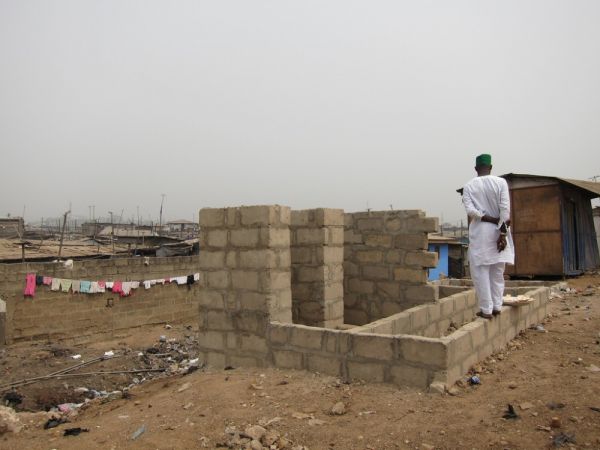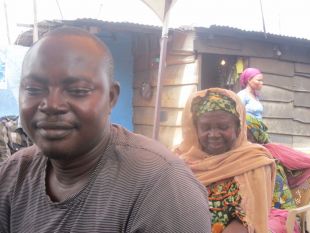How a Savings Bank Became One Slum’s Line in the Sand

Savings from the association in Old Fadama have allowed residents to upgrade their homes from wood to concrete. Photo credit: Shack Dwellers International
Salifu leads the chant: “Information!”
“Power!” the group responds, about 40 men and women seated in plastic chairs under a canopy to shade them from the searing late-morning sunlight. A few cement buildings between the rows of shacks are adorned with drying clothes, and a small minaret from the local mosque is just visible behind a row of tiny wooden houses.
“Information!” Salifu calls again.
“Power!” they respond.
“Information!”
“Power!”
“Busy!”
“For something!”
“Busy!”
“For something!”
“Busy busy!”
“For something something!”
“Busy busy busy busy!”
“For something something something something!”
Welcome to Old Fadama, a slum with influence. This is the weekly meeting of one of its informal credit and savings associations. The call-and-response is part of their weekly ritual, to be followed by the collection of savings from its members. Salifu Abdul-Mujeed, an exuberant social worker from the Ghana Federation for the Urban Poor, speaks to the assembled group in Dagbani, occasionally mixing in some Twi. He then translates into English, which another man translates into French for a delegation of visitors from Burkina Faso.
The credit association is a small but important organizational facet of the sprawling 77-acre slum known variously as Agogbloshie, Old Fadama and “Sodom and Gomorrah.” The settlement had an estimated 79,000 residents as of 2009, and a population density roughly ten times that of Manhattan. Though Old Fadama has existed since the early 1980s, the livelihoods of its residents are always under threat. Fires and floods regularly ravage the wooden houses and poorly drained land. As if these environmental threats weren’t enough, the land itself is government-owned, and the city faces constant public pressure to destroy the settlement, thanks to its stigma as a hotbed of prostitution and crime, from which it earned its biblical nickname. Furthermore, it is situated on land set aside for an ecological preserve designed to restore and protect the polluted Korle Lagoon. Several times, the government has threatened eviction, but so far Old Fadama has managed to resist.

Mohammed Alhassan, the association’s money collector. Photo credit: Sharon Benzoni
The savings and credit association is part of that resistance. It has been around for a decade, and members are expected to save at least 2 cedis ($1 USD) each week. Mohammed Alhassan is the collector, taking this money from each member and noting down their contributions in the collection books. He’s been part of the association for four years. Orphaned the age of fifteen, he had completed junior high school but was unable to afford the fees that would have allowed him to attend senior high school. So he moved to Accra to try to make a living. He now has five children and a wife, who is a tailor and also a member of the association.
“Where is Naa?” Salifu asks. A woman in red lace points over her shoulder, vaguely north. “Kumasi,” she says, indicating that Naa is in Ghana’s northern region today. On any given week, a fair number of the association’s members will not attend the meeting; many are traders who make long journeys to buy stock to sell in the city. The particulars of Old Fadama’s economy reflect, in part, the fact that most of its residents are Northerners. Mohammed travels to the northern city of Tamale to buy movies and songs produced there. They are made in the Northern languages – Dagbani is the most common — and are of more cultural relevance to Old Fadama’s residents than entertainment produced here in Accra. Similarly, 50-year-old Aisha produces traditional herbal medicines from plants harvested from the wild in the North. Her remedies, she says, can alleviate fever, stomach pain or back pain, among many other ailments. She uses the profits from her sales to pay her children’s school fees.
Members in good standing can take out loans of 40-800 Ghana cedis ($20-400 USD), and many take advantage of this, using the money to build homes out of cement blocks instead of wood, creating housing that’s protected from the fires that frequently sweep through the settlement. Others, like Alhassan, use them to buy stock for their businesses, increasing the range of products they can sell.
Informal credit systems abound in Accra, a reflection, perhaps, of a particularly African style of relationship, or simply the continued challenges people across social strata have in accessing capital. Prince One, the okada driver I wrote about last week, explained to me that one way for young men to start in the business is to use the “work-and-pay” system: Essentially, a patron who has some money, usually a friend or relative, buys a motorcycle for you to use for your business. Every week, you give some portion of your earnings to your patron, or “master,” as Prince One referred to his. A taxi driver had a similar story – every week he deposits 200 cedis (about $100 USD) into the bank account of the man who bought him the taxi. In eighteen months, he’ll own the car, after having paid back its cost with interest of about 18 percent.
The difference between this group in Old Fadama and the small-scale informal personal loans so commonplace in Accra is that this credit association has also become a center of community organization. In 2002, community leaders invited a group from Slum Dwellers International to visit Old Fadama, and the following year the first savings group was born. These savings groups were conceived from the beginning not just as money banks, but as centers around which the community could organize itself to ensure survival.
Salifu says that the Ghana Federation for the Urban Poor, which is the local partner of Slum Dwellers International, works with the groups not only on financial services, helping to ensure good accounting and payment practices, but also gives them a platform to leverage the resources of international organizations like United Nations Habitat and the World Bank. In partnership with SDI, they have undertaken a number of profiling surveys to compile real information about Old Fadama’s inhabitants – and to gain public sympathy in their battle with officials over forced evictions. The information gleaned from the surveys – including population data and information about its businesses and economy, began to transform the public image of Old Fadama, as Barbara Torresi put it, “from that of a biblical hotbed of crime into a flagship example of grassroot power.”
Now, groups like the delegation from Burkina Faso come to Old Fadama to learn how its organizations are run. Ashaiman, a huge informal community just outside the nearby port town of Tema, is undertaking similar initiatives. And the slum is slowly upgrading, as evidenced by the new cement buildings erected thanks to the loans, and the gleaming new toilet facility around the corner. Though they still face threats of eviction, the group isn’t afraid to take on politicians: another of the association’s rituals is an enthusiastic reinterpretation of a classic Ananse fable, which tells that “whoever intends to destroy this association should be caught by the shingles so they cannot even walk,” as Salifu explains it to me. In both bodies and balance sheets, it turns out, there is strength in numbers.









